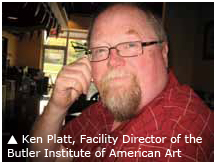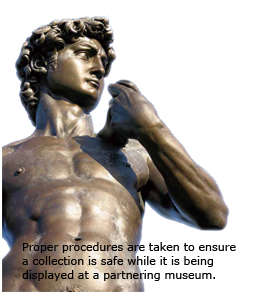Being able to sufficiently protect irreplaceable museum pieces takes much more than simply having a state-of-the-art security system. Museums must consider all the possible risks they may face and implement logical and efficient security protocols in the event of an emergency or security breach.
Museums and historical sites must be aware of all the risks they face. “In major museums, security directors conduct regular risk assessments to evaluate the effectiveness of their security systems,” said Sheila Palmer, Assistant VP of Loss Control Services, Chubb Group of Insurance Companies. “This can be done on an annual basis or whenever there is a significant change in exposure, such as the installation of a new, high-value or controversial exhibit, a change in adjacent or external exposures, or construction and renovation work.”
Being able to sufficiently protect irreplaceable museum pieces takes much more than simply having a state-of-the-art security system. Museums must consider all the possible risks they may face and implement logical and efficient security protocols in the event of an emergency or security breach.
Museums and historical sites must be aware of all the risks they face. “In major museums, security directors conduct regular risk assessments to evaluate the effectiveness of their security systems,” said Sheila Palmer, Assistant VP of Loss Control Services, Chubb Group of Insurance Companies. “This can be done on an annual basis or whenever there is a significant change in exposure, such as the installation of a new, high-value or controversial exhibit, a change in adjacent or external exposures, or construction and renovation work.”
RISKS DURING TRANSPORT
Many collections displayed in museums are on loan, and museums often partner up with one another to display their collections all over the world. Proper procedures are taken to ensure a collection is safe while it is being displayed at a partnering museum. “We always look at the facility that it is going to, the type of security they have and the institution's reputation,” said Ken Platt, Facility Director of the Butler Institute of American Art. “Their environmental controls and emergency plans — down to how many guards they have patrolling the display area — are fully studied and understood.”
Artworks are most vulnerable during transport. “Most art loss or damage occurs while the objects are being transported,” said Linda Sandell, Senior VP of Huntington T. Block Insurance Agency (an Aon company). “The two main prevention measures are to properly pack and ship objects by using materials and methods that take into account the object's size, climate considerations and fragility to minimize jarring and vibration during transit, and to maintain proper security during the loading and unloading process.”
Third-party vendors who specialize in transporting museum objects are called upon to pack and ship all collection pieces. “They typically have long-standing relationships with their vendors and have worked closely with them to ensure they understand the museum's expectations. These include specific details on the quality of the casing provided for the object,” Palmer said. “The museum must provide specific requirements for the cases since there is no standardized description of museum-grade cases. All objects should be shipped in unmarked vehicles that are equipped with alarms, air shocks and two drivers.”
 In the U.S., special consideration is paid to verify the identity of everyone who will be handling the shipment. “All employees must be approved by the Department of Homeland Security. This helps ensure that all employees of the shipper have met minimum security background checks.” Palmer said.
In the U.S., special consideration is paid to verify the identity of everyone who will be handling the shipment. “All employees must be approved by the Department of Homeland Security. This helps ensure that all employees of the shipper have met minimum security background checks.” Palmer said.
An employee of the museum will also travel with the collection to its destination and back. “We make sure to never leave the collection unattended by someone employed by the museum who owns the collection. Once, we were transporting our collection when one of the trucks broke down. I stayed in that truck overnight at the repair shop,” Platt said.
GUARDING EFFECTIVELY
There were two very notable art thefts in 2010 — one in Paris and the other in Egypt. “They were both state-of-the-art museums with expensive and elaborate security systems. However, none of them worked,” said Charles Hill, an art risk consultant. “This was mostly due not to faulty devices, but to defective management policies. These two museums have lost their reputations, and once a museum loses its reputation, it becomes harder for it to acquire traveling exhibits from other museums. Another example of a defective management policy would be the case of the Munch theft from the National Gallery in Oslo in 1994.” The theft occurred during the early hours of the morning. The guard on-site watched from the control room as the thief ran off with the painting while he followed procedure and called the director of the museum. “The theft was not stopped because the security procedure was simply inadequate.”
Relying only on the security system cannot provide the protection necessary for a museum housing priceless objects. “Emphasis should also be placed on the human aspect — a balance must be found,” Hill said. “Anything that can go wrong with a system will go wrong. So, it is important to not focus too heavily on the security system but to focus on the people who control the system and patrol the facilities.”
 Very rarely do museums hire guards from guarding companies, and all security guards who are hired go through an extensive background check. “We prefer to perform our own background checks and pick our own guards,” said Jo-Hsin Chi, Chief Curator, Department of Registration and Conservation, National Palace Museum of Taiwan. “All of our guards have had extensive training in this field and have been employed by our museum for decades. We must be certain our guards are trustworthy because the security system alone is not enough to protect all corners of the museum. Still, we take caution and do not offer our guards keys to the display or storage cases inside our vault.”
Very rarely do museums hire guards from guarding companies, and all security guards who are hired go through an extensive background check. “We prefer to perform our own background checks and pick our own guards,” said Jo-Hsin Chi, Chief Curator, Department of Registration and Conservation, National Palace Museum of Taiwan. “All of our guards have had extensive training in this field and have been employed by our museum for decades. We must be certain our guards are trustworthy because the security system alone is not enough to protect all corners of the museum. Still, we take caution and do not offer our guards keys to the display or storage cases inside our vault.”
Studies have shown that most thefts are carried out by museum insiders. “Employees and contractors know the layout and how to bypass the security system. A study conducted by the FBI in the U.S. show that 87 percent of museum robberies were carried out by insiders. This means that security must be as high, if not higher, against threats stemming from inside a museum than the outside,” Hill said.
This is why museums have recently begun using RFID cards to track their employees. “This allows the system to record exactly where one employee has been, or is, at all times,” Sinar said.
Proper museum procedures will also prevent any possible risks. For example, firm security measures are taken to control the people going in and out of the storage vaults at the National Palace Museum. “The storage rooms are never to be opened during business hours except for emergencies, such as a fire, and luckily that has not happened so far. In order to open the door during off hours, the three assigned people who have the authority to open the vault must all agree and enter the vault together. RFID cards are used, and cameras are placed to record all entries and exits from the storage space,” Chi said.
LOOKING AHEAD
Newer technology does not necessarily indicate perfect security unless it supports the risk assessment. But, newer technology may help a museum lower security expenses in the long term and offer some additional security program benefits, Palmer said.
 Still,many museums find new technologies on the market unsuitable to their needs. “We find biometrics to be not 100-percent reliable and fear it may hinder our access to certain areas during emergencies. RFID tags are not used by us because we cannot attach them onto delicate paper scrolls or small objects,” Chi said.
Still,many museums find new technologies on the market unsuitable to their needs. “We find biometrics to be not 100-percent reliable and fear it may hinder our access to certain areas during emergencies. RFID tags are not used by us because we cannot attach them onto delicate paper scrolls or small objects,” Chi said.
Currently, the biggest innovation in security is data trending, which allows authorities to predict something before it happens through predictive analysis. “For example, if you see the same person entering the museum 10 times a week, he or she could be surveying the property and planning a crime. The trend of a thief is very different from that of a common visitor,” Sinar said.
All elements, such as the security system, the human aspect and good procedures, must be thoroughly planned out to best secure a museum or historical site. “Museums should direct their security efforts toward resilience, which means preparation for the foreseen, or even the unforeseen. This could be anything from floods to looting during a riot,” Hill said.
One aspect of security should never outweigh others. Sometimes, common sense and proper management procedures combined with technology can be more effective than an advanced security system alone.